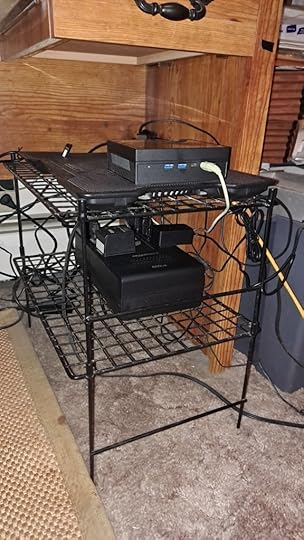I have the power (strip)!
It took a while, but that new power strip with battery backup finally arrived. I ordered it largely out of the suspicion that my auto-reboot problem might be due to brief power dropouts, but since I haven’t had an auto-reboot in the nearly 2 weeks since I ordered it, I don’t think that’s the issue. Still, I had been concerned about this mini-PC not having battery backup like my laptop, so I’m glad to have the safeguard.
The instructions recommended letting the battery charge for 8 hours before plugging anything into it, which was probably unnecessary, but I didn’t feel up to unplugging everything yesterday, so I waited until this morning to do it.

The inclusion of the battery and, apparently, its cooling system makes the power strip surprisingly huge and heavy. Ironically, the power source is something like 3 times the size of the computer it’s powering!
Only the four outlets on the right have battery backup, while the four on the left are just surge-protected. I was hoping I could plug the computer, modem, monitor, and speakers into the battery side, but too many of them had those big transformer boxes and only the two outlets nearest the camera have enough space on the sides to accommodate them. So I had to plug the speakers in on the non-battery side, with the printer taking the fourth battery-side slot. I suppose it doesn’t matter, though; apparently the battery only provides about half an hour of power, enough to wrap up what you’re doing and shut down if there’s a blackout. So it’s not like I could keep watching a movie or something if the power went out. (And if I did need audio during that time for some reason, I could just unplug the speakers and plug in headphones.)
Before, I had eight different items plugged into two power strips: computer, monitor, modem, speakers, printer, USB hub, paper shredder wastebasket, and phone charger. I could only use seven of the outlets, but my phone charger cord has a detachable plug, so I just plugged it into the USB hub. Which means now my computer reads the phone as a device when I charge it, but somehow I can’t find its files in Windows 11’s bizarrely overcomplicated and repetitive directory tree. Though I was able to use the “Link to computer” function to upload the above photo from my phone to my PC.
The power source comes with a USB cable and supposedly has downloadable power management software from Amazon, I guess so the PC can read how much battery life is left or something. But looking over the Q&A section on Amazon gives me the impression that the software is either nonexistent or hard to find, and is optional in any case. So I decided not to bother. Ironically, the unused USB cable has the same type of connectors as the new printer cable I bought recently, and appears long enough to reach, so I wish I’d gotten this before I bought that printer cable. Although this cable is thinner, so maybe it’s not the right type somehow.
It looks a bit concerning having so many devices powered from the same wall outlet, but that outlet has reliably provided power to all those devices for quite a few years, so I guess it’s okay. (The other item plugged into the wall is my landline phone. I turn off my power strips for safety when I go on a trip, but leave the phone plugged in so it can take messages.)
It’s interesting that all my old power strips were white plastic with red power lights, but this is the negative of that, black plastic with a green power light. By the same token, all my newer electronics are black, but my old computer speakers are off-white. There seems to have been an inversion in the fashion for electronic devices. I wonder, why has black become the default color? If anything, I’d think white would be better because it absorbs less heat from outside and reduces the risk of overheating.



